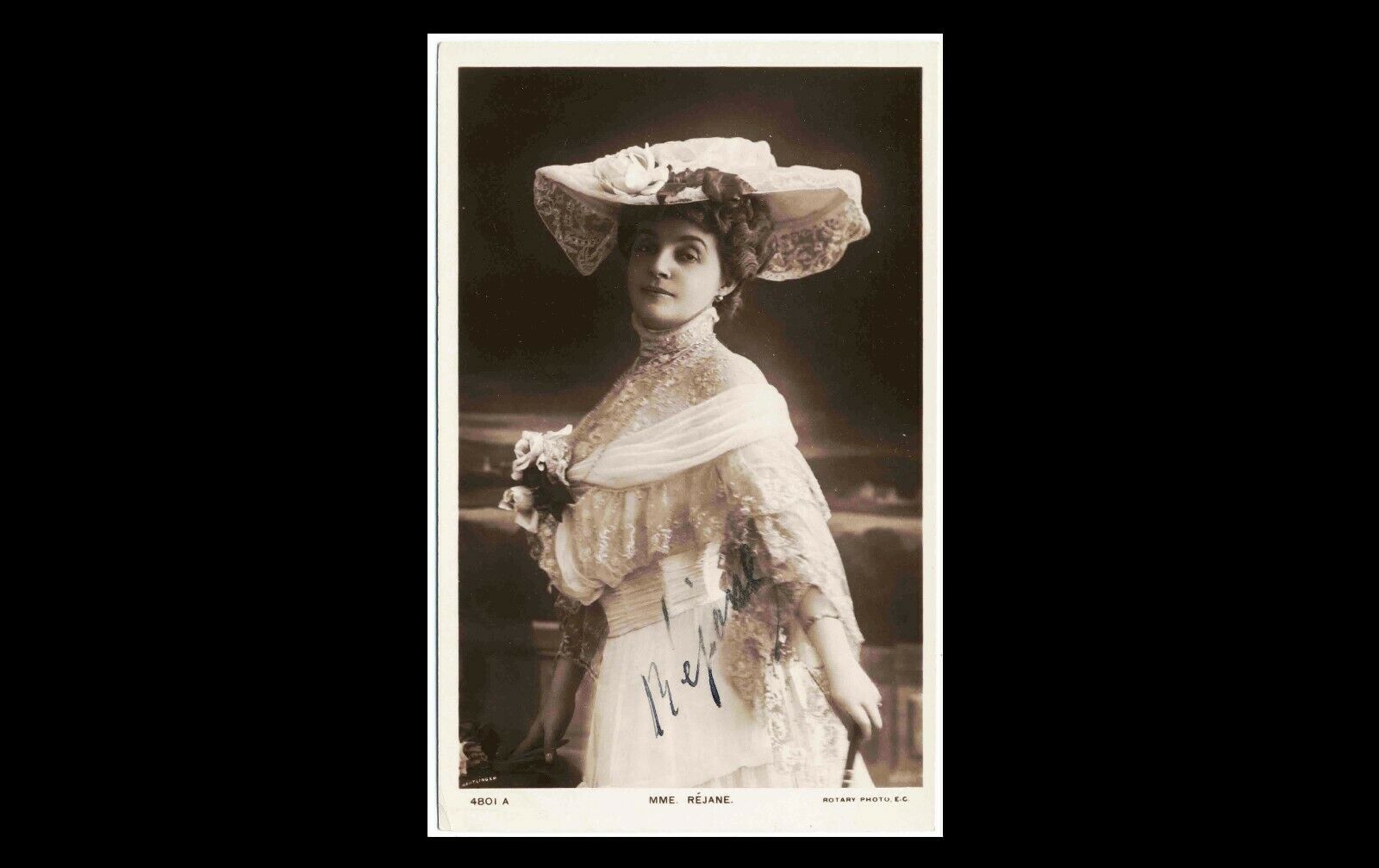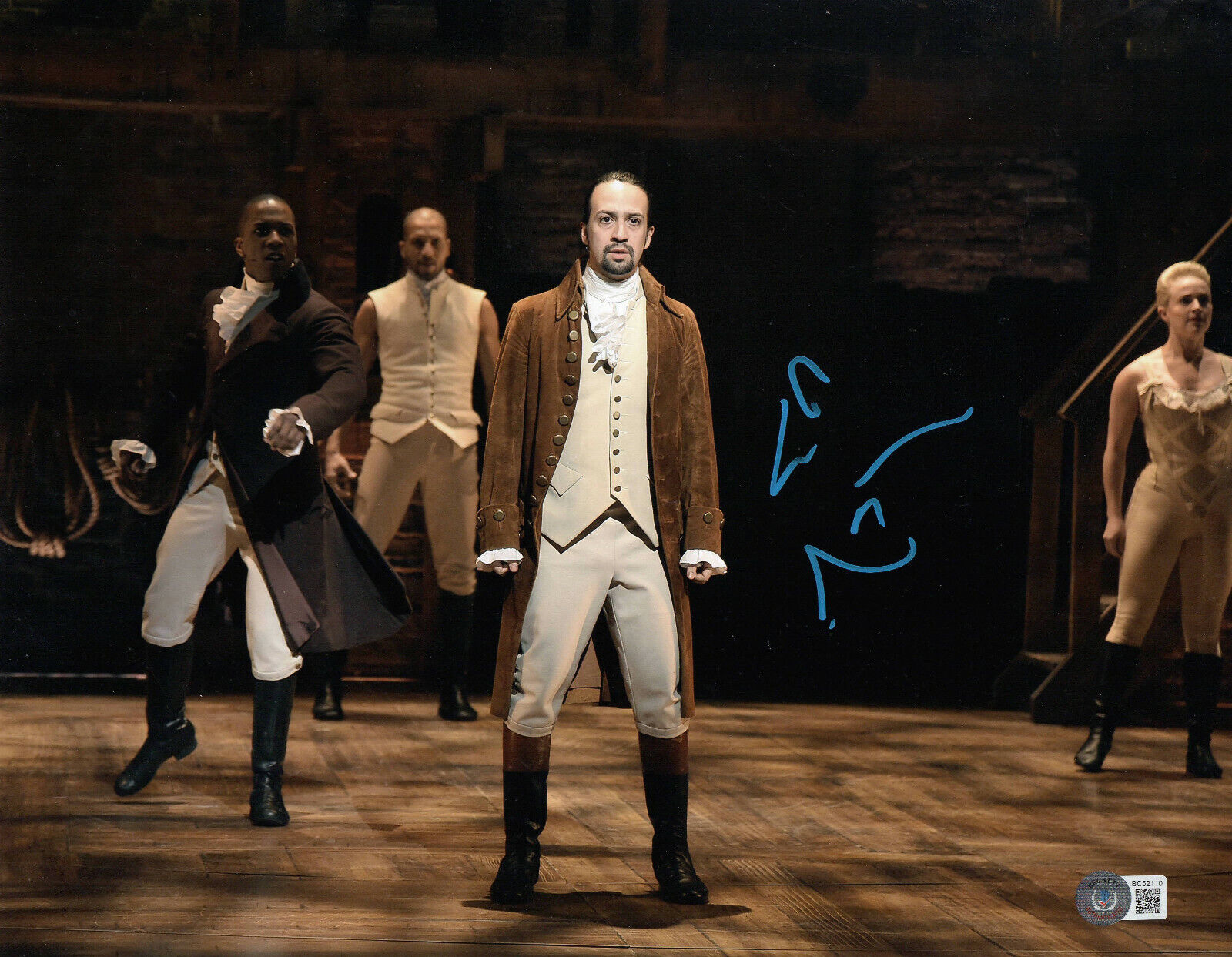-40%
Early Signed Theaterical Stage ACTRESS Icon GABRIELLE REJANE RPPC Photograph
$ 50.16
- Description
- Size Guide
Description
EARLY SIGNED THEATRICAL STAGE ACTRESS GABRIELEE REJANE RPPC PHOTOGRAPH POSTCARDSigned RPPC Photograph
Autograph
photograph RPPC postcard signed of the French singer, actress, and dancer that was internationally known for her beauty and acting prowess.
Circa 1910-1915 image shows actress in thick blonde curl hair and a Gay 1890's dress and large feather lace hat.
Image dated early in the actresses career and is inscribed in large flowing black ink - "Rejane"
Wear to card consistent with age and use. Two minor creases to lower left hand corner.
Please see all photos as they are part of the description. Signature executed in
script. Guaranteed authentic.
&&&&&&&&&&&&&&&&&&&&&&&&&&&&&&&&&&&&
LIFE & CAREER - EARLY LIFE
Réjane aged 16
Réjane was born in Paris on 6 June 1856. Her father, a former actor, was on the front-of-house staff of the Théâtre de l'Ambigu-Comique. He died when Réjane was about five, leaving his widow in straitened circumstances. She obtained a post at another Parisian theatre, and the young Réjane painted fans to augment the family income. In 1870–71 her education, at the Pension Boulet, was interrupted by the Siege of Paris and the bloody events of the Commune.[5] After the fighting ended she returned to her studies and was appointed as a paid assistant to look after the younger pupils.
Réjane had ambitions to go on the stage, and, having obtained a reluctant consent from her mother, she successfully applied to François-Joseph Regnier, a distinguished actor and teacher, for admission to his class at the Paris Conservatoire. In 1874 she won the Conservatoire's deuxième prix (second prize) for comedy. The critic Francisque Sarcey held that she deserved the premier prix, but "A first prize carries with it the right of entrance into the Comédie-Française, and the jury did not think Mademoiselle Réjane, with her little wide-awake face, suited to the vast frame of the House of Molière".
According to the official regulations, Réjane, as a winner of the deuxième prix, was required to join the company of France's second national theatre, the Odéon, but she preferred the repertoire and better pay at the Théâtre du Vaudeville, and the Odéon management did not press the point. She made her debut at the Vaudeville in 1875 in the prologue to the Revue des deux-mondes, by Clairville, making an immediate impression. A reviewer commented, "She has the arch and sprightly air of a Parisian grisette, a flexible voice of an agreeable tone, and perfect self-possession – qualities more than sufficient to succeed on the stage". Later in the year she had her first substantial success, as Niquette in the comedy Fanny Lear by Henri Meilhac and Ludovic Halévy. She remained at the Vaudeville for eight seasons, attracting good notices. The established star at the theatre, Julia Bartet, had the lion's share of leading roles, but Réjane made her mark. The critic Dauphin Meunier later wrote:
Shall I show her as the sly soubrette in Fanny Lear? as the woman in love, "whose ignorance divines all things", in Madame Lili? as the comical Marquise de Menu-Castel in Le Verglas? Shall I tell of her first crowning success, when she played Gabrielle in Pierre?
In 1877 Réjane made the first of many appearances in London. Parisian theatres customarily closed for a few weeks during the height of summer, and in July, with Vaudeville colleagues, she played at the Gaiety Theatre in the West End in the comedies Perfide comme l'onde, Nos alliées and Aux crochets d'un gendre.[n 3] The Athenaeum applauded "a display of vivacity and espièglerie quite exceptional on the part of Mdlle Réjane", and The Morning Post found her "infinitely diverting".
Variétés and stardom
As Riquette in Ma cousine, 1890
In 1882, the year after the retirement of Hortense Schneider, star of the Théâtre des Variétés, Réjane was engaged as leading lady there. Her contract at the Variétés allowed her to appear in more serious roles in other theatres, and in 1883 Sarah Bernhardt, who was then running the Ambigu, cast her in the central role of Jean Richepin's La Glu; in that part, and as Adrienne de Boistulbé in Meilhac's Ma camarade at the Théâtre du Palais-Royal in the same year, Réjane attracted highly favourable critical attention.
Over the next ten years Réjane appeared at six or more Paris theatres, in an exceptionally wide variety of plays, from new works by Edmond Gondinet (Clara Soleil, 1885), Meilhac (Les demoiselles Clochart, 1886, and Ma cousine, 1890), Victorien Sardou (Marquise, 1889) and Edmond Haraucourt (Shylock, 1889), to revivals of classics by Beaumarchais (Le mariage de Figaro, 1889), Dumas (La Demi-Monde, 1890) and Aristophanes (Lysistrata, 1892.She continually showed the range of her abilities as an actress: in 1887 in Allô-Allô she played a scene grappling with the difficulties of the new-fangled telephone, which, Meunier recalled, was so funny "that from the gallery to the stalls the theatre was one roar of laughter and applause". In the following year she appeared at the Odéon in a stage adaptation of Germinie Lacerteux by the Goncourt brothers. The actor and director André Antoine described her performance:
... an unexpected, unrecognisable Réjane. Here was the elegant Parisienne, hunched and frumpish. in the clothes of a poor maid – so convincingly transformed into the shape of humanity that she had become Germinie Lacerteux herself. ... Above all in the second part, when Germinie, gradually decaying, growing old, trails her grief – is so truly of the people. It was then that the actress finally achieved greatness.
Among those who saw the performance was Marcel Proust who became a devoted admirer, and later friend; his character Berma, the great actress in À la recherche du temps perdu, is partly based on Réjane.
In 1893 Réjane married Paul Porel, director of the Vaudeville; they had two children – Germaine and Jacques. She appeared at the Vaudeville in a series of successful plays; two of the earliest productions demonstrated her range. In October 1893 she created the role with which she was most closely associated during the rest of her career: Catherine, the outspoken washerwoman-duchess in Sardou and Moreau's historical comedy-drama Madame Sans-Gêne. The critical and public response was enthusiastic. In Le Figaro, Henry Fouquier judged that Réjane had turned an artificial character into something delicious, feminine and overwhelming. Another reviewer wrote:
As Catherine, Duchesse de Dantzig, in Madame Sans-Gêne Madame Réjane, who played the extremely difficult title rôle of the piece, gained a distinct personal triumph by sheer dint of clever acting. She invested the character of the vulgar but honest Duchesse de Dantzig with a thousand sympathetic and laughable traits, many of which were conceived in the highest spirit of comedy. She was by turns fascinating and espiègle ... pathetic ... subtly diplomatic ... proud almost to sublimity ... and all the time she never ceases to be the restless, talkative gamine of the Paris streets. ... People will crowd to the Vaudeville if it is only for the purpose of seeing Réjane in the character of Madame Sans-Gêne.
Six months later Réjane played Nora in the French premiere of Henrik Ibsen's A Doll's House ("Une maison de poupée"). Ibsen had never succeeded with Parisian audiences until now, but to his delight the production was a triumph. Les annales du théâtre et de la musique recorded, "Nora's role is overwhelming; Mademoiselle Réjane took the opportunity of one of the greatest successes of her career. She was able to highlight the very complex character of the role, and with a rare simplicity of means she demonstrated in the famous tarantella scene an admirable dramatic power. Needless to say, it was acclaimed".
Another contemporary critic wrote:
The range and delicacy of her playing were equally remarkable, and it was extraordinary with what consummate ease she passed from the lightest gaiety and espièglerie through a thousand varying and contrasting phases of passion and sentiment to the final tragic heights of her soul-awakening when she perceives the mistake of her life and refuses any longer to be a mere doll dandled in the strong arms of her somewhat coarse-grained husband. So complete, incisive, and at the same time exquisitely charming an exposition of Ibsen's subtly drawn character of Nora has probably never been given before.
LONDON & NEW YORK
In 1894 Réjane returned to the West End. Since her first appearance there, in 1877, she had been in a production of Alphonse Daudet's Le Nabab at the Gaiety in 1883. Her reviews then had been good, but her return in June 1894 in Madame Sans-Gêne prompted superlatives from the critics and drew full houses, even with the counter-attraction of a Bernhardt season at Daly's Theatre. Réjane's season had to be extended by a fortnight to meet demand.
A Doll's House, included in Réjane's 1895 New York season. In February 1895 Réjane opened at Abbey's Theatre in New York for a season comprising Madame Sans-Gêne, Divorçons, Sapho, Ma cousine and A Doll's House. Reviews for Réjane were excellent, but less so for the plays, and audiences were unresponsive: as an American commentator put it, "The language was, of course, one stumbling block, for a keen understanding of the foreign tongue was more necessary for a taste for Réjane than for the broad effects, say, of a Bernhardt". Among those in the audience who understood the words there was a substantial section whose broadness of mind did not extend to the content of French plays. The New York Times later commented that Réjane was "hampered by the moral bias of American audiences."
Réjane was so disgusted at the lack of appreciation that she vowed never to return. She took her company back to Paris via London, where they played a season of most of the same plays to full houses at the Garrick Theatre. Madame Sans-Gêne was once again an immense success, and Sir Henry Irving negotiated the rights to stage an English version, which he produced at the Lyceum Theatre with Ellen Terry in Réjane's role two years later.
Réjane eventually relented and agreed to return to the US, but not until 1904, by which time she had been seen by audiences in Belgium, Denmark, the Netherlands, Germany, Russia, Austria, Romania, Italy, Spain and Portugal. In the meanwhile, at home her marriage was disintegrating, and in 1905 she and Porel were divorced. The children remained with her. The Vaudeville, under Porel's management, being now closed to her, Réjane decided to go into management on her own account.
Théâtre Réjane AND LATER YEARS
Réjane was not long without a theatrical base. In 1906 the writer Arnold Bennett, then resident in Paris, wrote:
She took hold of the Nouveau Théâtre, the unlikeliest and one of the most uncomfortable theatres ... She removed everything from within its four walls, and presently frequenters of the Rue Blanche observed that the legend Théâtre Réjane had been carved on its façade. ... [Audiences] went, and discovered the wonderfullest theatre in the town, incredibly spacious, with lounges as big as the auditorium, wide corridors, and a scheme of decoration at once severe and splendid. Réjane was written all over it, even in the costumes of the women attendants. Paris was charmed, astounded, electrified; and now Réjane flames a more brilliant jewel than ever in the forehead of the capital.
At the Théâtre Réjane its proprietor appeared in twenty new plays and revivals by playwrights ranging from the grandiose Catulle Mendès to the chic Sacha Guitry between 1906 and 1910 – "none of them, perhaps, a new Sans-Gêne or Marquise", according to her biographer Forrest Izzard, "but each serving to keep in vigorous use one of the rarest talents of the time". Réjane did not appear in every production at her theatre; she was not in the cast of the French premiere of Maurice Maeterlinck's play The Blue Bird ("L'oiseau bleu"), given at the Théâtre Réjane in March 1911. How did she confine her appearances in Paris to her own theatre; in 1911 and 1916 she appeared at the Théâtre de la Porte Saint-Martin in Henry Bataille's L'enfant de l'amour and L'amazone.
As well as her base in Paris, Réjane hoped to found a French repertory theatre in London. A first step was made in 1906 with a season at the Royalty Theatre, but the plan was not taken further. Réjane sold her Paris theatre in 1918, after which its name was changed to the Théâtre de Paris.
Réjane took part in six silent films. Two were versions of Madame Sans-Gêne, the first directed by Clément Maurice, 1900, and the second by André Calmettes, 1911. The others were Britannicus (Calmettes, 1908), L'Assomoir (Albert Capellani, 1909), Alsace (Henri Pouctal, 1916) and Miarka (Louis Mercanton, 1920).
During the First World War, Réjane devoted much effort to helping the Allied cause, and she appeared at the Royal Court Theatre, London, in a patriotic drama called Alsace, and at the London Coliseum in a war-play entitled The Bet. She was made a Chevalier of the Legion of Honour, an event celebrated in February 1920 by a luncheon at the Théâtre de Paris, presided over by President-elect Paul Deschanel.
Réjane died of influenza in Paris on 14 June 1920, aged 64. The following day the front page of Le Figaro bore the words, "Réjane est morte... Du silence, messieurs et mesdames du Paris de 1920, un peu de silence. Et pour nous, des larmes. Nous perdons l'âme de Paris". – Réjane is dead. ... Silence, gentlemen and ladies of Paris, 1920, a little silence. And for us, tears. We lose the soul of Paris".
&&&&&&&&&&&&&&&&&&&&&&&&&&&&&&&&&&&&&&&&&&&&&&&
Image measures 3 3/8" x 5 3/8" including borders.
ASK ALL QUESTIONS BEFORE BIDDING.
BE SATISFIED WITH WHAT YOU ARE SEEKING TO BUY.
AS SHOWN ABOVE - SOLD "AS-IS." NO RETURNS.
STANDARD PRIORITY
SHIPPING is .00 w/ DELIVERY CONF. INSURANCE INCLUDED. Includes 15% EBAY SELLER'S SHIPPING SURCHARGE.
WE DO NOT SHIP BY UPS as they rip open boxes insured at 0 or more seeking to deny
shipments containing antiques. ALL SHIPMENTS NORMALLY MADE THROUGH USPS -
BUT WE RESERVE THE RIGHT TO SEND BY FEDERAL
EXPRESS GROUND INSURED.
OVERSEAS SALES pays .00 for secure REGISTERED AIRPOST with minimal declaration
f
or easy and secure Customs clearance and safe signature delivery. GA STATE residents
must pay 8% STATE SALES TAX.
GOOD LUCK! WE COMBINE SHIPPING!












